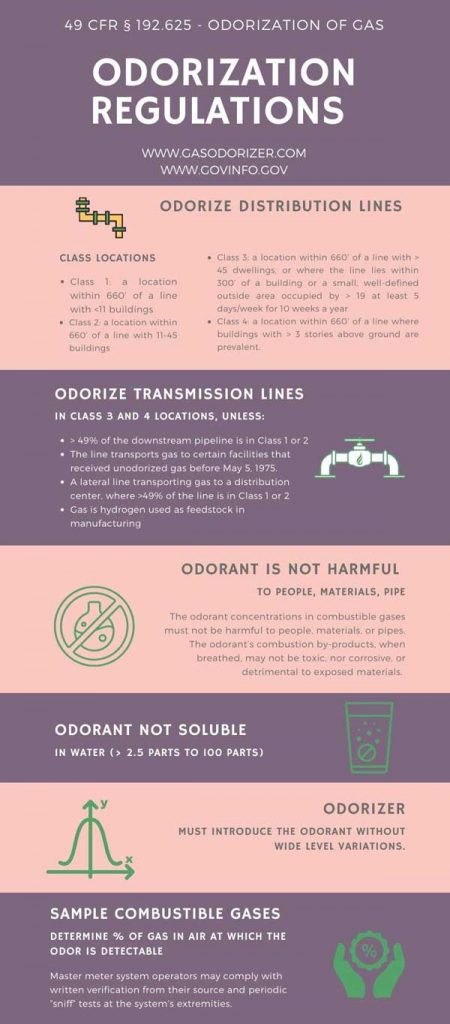What are the natural gas odorization regulations? Plain and simple, in the U.S., any odorless gas within a distribution or transmission line (exceptions noted in the rules*) must contain odorant at the level of 20% or 1/5 the lower explosive limit so that a person with an ordinary sense of smell can detect it.
These natural gas odorization regulations are mandated by the Public Safety Regulations of the Department of Transportation in section 192.625. I’ve published them here for you to see.
 Natural Gas Odorization Regulations
Natural Gas Odorization Regulations
PART 192: TRANSPORTATION OF NATURAL AND OTHER GAS BY PIPELINE: MINIMUM FEDERAL SAFETY STANDARDS**
Subpart L: Operations
192.625 – Odorization of gas.
(a) A combustible gas in a distribution line must contain a natural odorant or be odorized so that at a concentration in air of one-fifth of the lower explosive limit, the gas is readily detectable by a person with a normal sense of smell.
(b) After December 31, 1976, a combustible gas in a transmission line in a Class 3 or Class 4 location must comply with the requirements of paragraph (a) of this section unless:
(1) At least 50 percent of the length of the line downstream from that location is in a Class 1 or Class 2 location;
(2) The line transports gas to any of the following facilities which received gas without an odorant from that line before May 5, 1975;
(i) An underground storage field;
(ii) A gas processing plant;
(iii) A gas dehydration plant; or
(iv) An industrial plant using gas in a process where the presence of an odorant:
(A) Makes the end product unfit for the purpose for which it is intended;
(B) Reduces the activity of a catalyst; or
(C) Reduces the percentage completion of a chemical reaction;
(3) In the case of a lateral line which transports gas to a distribution center, at least 50 percent of the length of that line is in a Class 1 or Class 2 location; or
(4) The combustible gas is hydrogen intended for use as a feedstock in a manufacturing process.
(c) In the concentrations in which it is used, the odorant in combustible gases must comply with the following:
(1) The odorant may not be deleterious to persons, materials, or pipe.
(2) The products of combustion from the odorant may not be toxic when breathed nor may they be corrosive or harmful to those materials to which the products of combustion will be exposed.
(d) The odorant may not be soluble in water to an extent greater than 2.5 parts to 100 parts by weight.
(e) Equipment for odorization must introduce the odorant without wide variations in the level of odorant.
(f) To assure the proper concentration of odorant in accordance with this section, each operator must conduct periodic sampling of combustible gases using an instrument capable of determining the percentage of gas in air at which the odor becomes readily detectable. Operators of master meter systems may comply with this requirement by –
(1) Receiving written verification from their gas source that the gas has the proper concentration of odorant; and
(2) Conducting periodic “sniff” tests at the extremities of the system to confirm that the gas contains odorant.
[35 FR 13257, Aug. 19, 1970]Natural Gas Odorization Reference:
What are the Natural Gas Odorization Requirements or … (n.d.). Retrieved from https://www.lincenergysystems.com/linc-energy-blog/entry/natural-gas-odorization-requirements






